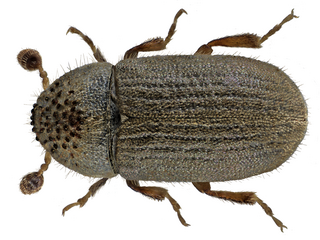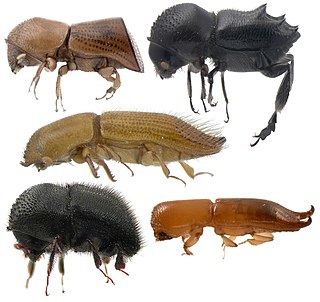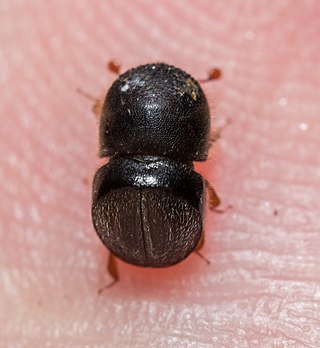Related Research Articles

The Curculionidae are a family of weevils, commonly called snout beetles or true weevils. They are one of the largest animal families with 6,800 genera and 83,000 species described worldwide. They are the sister group to the family Brentidae.

A bark beetle is the common name for the subfamily of beetles Scolytinae. Previously, this was considered a distinct family (Scolytidae), but is now understood to be a specialized clade of the "true weevil" family (Curculionidae). Although the term "bark beetle" refers to the fact that many species feed in the inner bark (phloem) layer of trees, the subfamily also has many species with other lifestyles, including some that bore into wood, feed in fruit and seeds, or tunnel into herbaceous plants. Well-known species are members of the type genus Scolytus, namely the European elm bark beetle S. multistriatus and the large elm bark beetle S. scolytus, which like the American elm bark beetle Hylurgopinus rufipes, transmit Dutch elm disease fungi (Ophiostoma). The mountain pine beetle Dendroctonus ponderosae, southern pine beetle Dendroctonus frontalis, and their near relatives are major pests of conifer forests in North America. A similarly aggressive species in Europe is the spruce ips Ips typographus. A tiny bark beetle, the coffee berry borer, Hypothenemus hampei is a major pest on coffee plantations around the world.

Cryphalus is a large genus of tiny bark beetles, subfamily Scolytinae, tribe Cryphalini in the family Curculionidae. The genus is widely distributed. The species feed and breed under the inner bark of trees. They infest mainly recently dead, dying or stressed trees. Some species are regarded as invasive pests, harmful to agriculture or forestry.
Isthmomys is a genus of rodent in the family Cricetidae, belonging to the tribe Reithrodontomyini. Species are:

Xyleborini are a tribe of ambrosia beetles, highly specialized weevils of the subfamily Scolytinae. Much of the ambrosia beetle fauna in Eurasia and the Americas consists of Xyleborini species. Some Xyleborini are notorious invasive species.

Laemophloeidae, "lined flat bark beetles," is a family in the superfamily Cucujoidea characterized by predominantly dorso-ventrally compressed bodies, head and pronotal discs bordered by ridges or grooves, and inverted male genitalia. Size range of adults is 1–5 mm (0.04–0.2 in) in length. Currently, it contains 40 genera and about 450 species, and is represented on all continents except Antarctica; species richness is greatest in the tropics.

Scolytus is a genus of bark beetles. It includes several species notorious for destroying trees in the forests. The Dutch elm disease is spread in North America by two species : the native elm bark beetle, Hylurgopinus rufipes, and the European elm bark beetle, Scolytus multistriatus. In Europe, while the aforementioned Scolytus multistriatus again acts as vector for infection, it is much less effective than the large elm bark beetle Scolytus scolytus.

Ips is a genus of beetles in the family Curculionidae, the true weevils. They are bark beetles, members of the subfamily Scolytinae. Species are distributed throughout the Northern Hemisphere. Some are known as introduced species in Australia and Africa. Many species are pests of forest trees, especially pines and spruces. They are known commonly as engraver beetles, ips engraver beetles, and pine engravers.
Coptodryas elegans is a species of ambrosia beetles in the tribe Xyleborini. It is found in Asia and the Pacific. The type locality is Raja Bhat Khawa in Bengal. It can be found on Albizzia moluccana, Eugenia jambolana, Lansium sp. and Shorea robusta.

Phloeoditica is a genus of bark beetles in the Phloeosinini tribe. Species includes Phloeoditica curta and Phloeoditica elegans.

Cnesinus is a genus of beetles in the subfamily Scolytinae. Species are from North America, Central America and South America.

Rallicola is a genus of chewing louse. It is an ectoparasite of rails and other birds. It was named by Thomas Harvey Johnston and Launcelot Harrison in 1911. There are two subgenera aside from the nominotypical subgenus: Aptericola, whose species are found on kiwi birds, and Huiacola, a monospecific subgenus consisting of Rallicola extinctus, once found on the huia.

Hypothenemus is a genus of oriental bark beetles in the family Curculionidae. There are more than 200 described species in Hypothenemus. They are common in tropical and subtropical areas worldwide, and found less often in temperate areas of eastern North America and eastern Asia. The small beetles are typically 0.6 mm to 2.2 mm in length, males smaller than females.

Cnestus is a genus of ambrosia beetles.

Dryocoetes is a genus of beetles belonging to the family Curculionidae, in the subfamily Scolytinae.
Coccotrypes flavicornis, is a species of weevil found in Sri Lanka.
Arixyleborus malayensis, is a species of weevil found in India, Sri Lanka, China, Japan, Malaysia, Vietnam and Indonesia. This is the only species of Arixyleborus found in Japan and China.

Euwallacea is a genus of typical bark beetles in the family Curculionidae. They are commonly known as Ambrosia beetles, as all species are symbiotic with Ambrosia fungi. Originally from Asia or Wallacea, they are now found worldwide. Many species are pests, causing damage to, or the death of, tree species valued for their fruit or timber.

Cryphalus dorsalis is a small bark beetle, 1.60–1.90 mm long and found in southern parts of Asia with a distribution range from India in the west to Java (Indonesia), the Philippines and southern China in the east. Little information is available on its biology, even on its host plants. In a detailed re-description of the species based on light trap material and specimens without host plant records, Johnson et al. (2020) mentioned that fir (Abies) has been cited as a host plant in one publication which recorded it from Hainan Island (China) where Abies does not grow.
References
- ↑ Classification of the Cryphalinae with descriptions of new genera and species. AD Hopkins - 1915
- Beaver, R.A. 2010: A review of the genus Hadrodemius Wood, with new synonymy and a key to species (Coleoptera: Curculionidae: Scolytinae). Zootaxa, 2444: 51–57